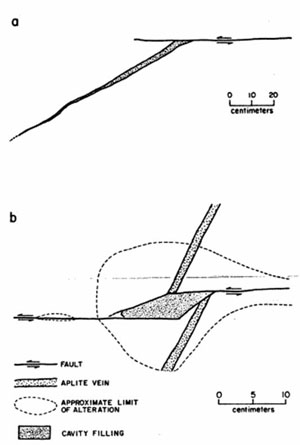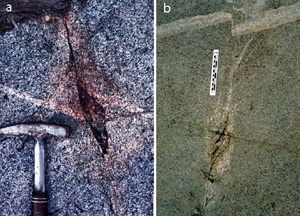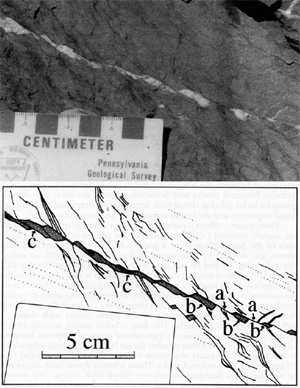|
Pull aparts are localized dilation along faults. They are often filled by precipitants and in some cases by magma. Pull-aparts in general may occur as dilational splay fractures as illustrated in (Figure 1). However, commonly, they have rhomb shapes and are associated with steps and bends along faults. As illustrated in a series of figures (Figure 2 and Figure 3), they occur in various sizes of similar geometry (Aydin and Nur, 1982). Some large size pull-aparts are composite features produced by merging of nearby dilation features. Interested readers may examine the references provided.
 | | Figure 1. Drawing of (a) wedge-shaped and (b) rhomb-shaped pull-apart openings associated with small faults in granitic rocks of Sierra Nevada, California. The wedge-shaped pull-apart occurs near the end of a single left-lateral fault. The rhomb-shaped pull-apart is formed between two echelon left-lateral faults, one which offsets an applied dike (in two o'clock direction) for about 5 cm (drawing from Figure 3a). Notice the hydrothermal alteration or halo (within dashed curve) around the pull-apart. From Segall and Pollard (1983). |
 | | Figure 2. Outcrop photos showing pull-aparts filled with epidote along left-lateral strike-slip faults in granodioritic rocks, Sierra Nevada, California. (a) from Segall and Pollard (1983), and (b) from Pollard and Fletcher (2005). |
 | | Figure 3. Photograph and drawing of a bed-parallel echelon thrust fault array. Individual thrust faults (labeled as 'a') are slightly oblique to bedding (dotted lines). Adjacent faults are connected by calcite-filled pull-aparts (labeled as 'b'). A composite pull-apart vein is marked as 'c.' From Ohlmacher and Aydin (1995). |
| |


